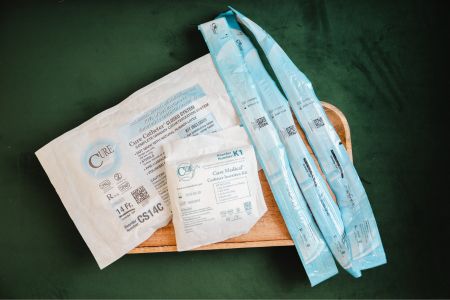
Do you find that your monthly orders of sterile intermittent catheters still aren’t covering your needs? As of May of 2019, Medicare has recently changed the guidelines on the number of covered catheters per month. Based on this change, you may qualify for more than 200 catheters per month to better cover your needs.
Is it possible to receive over 200 catheters per month with Medicare?
Typically, if you self-catheterize between 6 and 7 times per day, 200 sterile catheters and lubricating jelly packets should be enough. However, if you run out of catheters or run low every month, it’s possible that you may qualify for more.
Usually, this frequent shortage is due to a unique medical condition or an above-average urine output.
If you feel you may qualify, keeping a cathing journal or a written schedule may help you and your doctor better understand your body’s urine production, typical output, and frequency of catheterizations.
In 2019, CGS (CIGNA Government Services) for Medicare discontinued their prior guidelines to limit intermittent catheters to only 200 per month (or 600 every 3 months).
Nevertheless, it’s important to note that Medicare still requires proof in the form of medical documentation from a qualified healthcare practitioner.
How do I qualify for more than 200 catheters under Medicare?
With the discontinuation of the old guidelines, you may be able to qualify in one of two ways:
- If your physical anatomy is such that a greater amount of catheters is required.
- If your urine output exceeds the guidance listed below.
Urine Output Guidance
Typically, urine production is around 30 to 80 cc per hour, which adds up to about 800 to 2,000 cc per day. Considering this model of urine production, a person would make about 210 to 270 cc of urine between episodes of catheterization. This ultimately equates to a maximum need of fewer than 200 catheters per month.
Based on this, a model catheterization schedule at maximum would typically fall around six times per day. This would equate to a need for only 180 sterile catheters per month.
In a cathing schedule with 8 hours of sleep time at night, one would need to self-cath around every 160 minutes (just over every two and a half hours) in order to warrant a need for six catheters per day (180 catheters per month). Additionally, in a cathing schedule with only 4 hours of sleep time, self-cathing every 200 minutes (over every 3 hours) would still be covered with no more than 180 catheters per month.
You would have to fall outside of these guidelines in a very unique situation in order to potentially qualify. However, Medicare does require specific documentation.

What documentation is required to receive more than 200 catheters per month with Medicare?
Again, this is an exception that is only applicable under certain limited conditions. With supporting medical documentation from a prescribing physician, certain catheter users may qualify for more than 200 catheters per month.
In order to be acceptable, documentation must:
- Be thorough and include a specific reason for an exceptional need for more catheters
- Detail the specific diagnosis and frequency needs, in addition to the permanency of the condition leading to the need to use intermittent catheters
- Be in the medical record by the ordering healthcare practitioner with prescriptive authority (i.e., not a nurse or a telephone encounter)
- Include information as to why another form of treatment is not acceptable, such as a Foley catheter, surgery, etc.
Please note that the following items do not qualify as acceptable documentation for Medicare:
- Letter of Medical Necessity (LMN)
- To Whom It May Concern letter
- Any documentation that is not official medical notation from a qualified healthcare practitioner with prescriptive authority
What else should I know about receiving more catheters than the limited amount?
To find out more about your options, see your prescribing healthcare practitioner. They will be the best source to determine whether more than 200 intermittent straight catheters per month are necessary. They can also determine if an alternative treatment option could work for you based on your individual medical condition.
For example, if you live with male urinary incontinence, your doctor may decide to add male external catheters alongside the current number of intermittent straight catheters you receive each month. External catheters, also known as condom catheters, may control your bladder leakage between self-cathing times. This could potentially help you to not exceed a need for more than 200 intermittent catheters per month.
What Medicare-Covered Catheters Are Right for Me?
For more information about Medicare Guidelines regarding catheter coverage, see our helpful post here.
Do you want to find out more about your Medicare-covered catheter product options? 180 Medical is here to help.
Our team of Documentation Specialists will gladly do the footwork to gather any necessary documentation from your doctor’s office. We want to make the process of getting your catheter supplies as simple and worry-free for you as possible.
Contact 180 Medical today! Together, we’ll discuss what intermittent catheters or other incontinence supplies may work best for your unique needs.